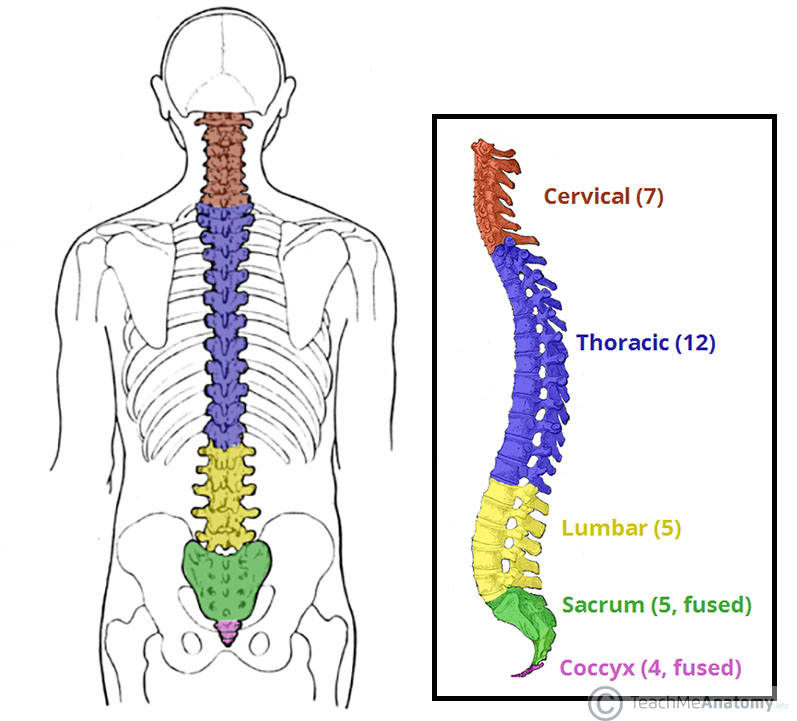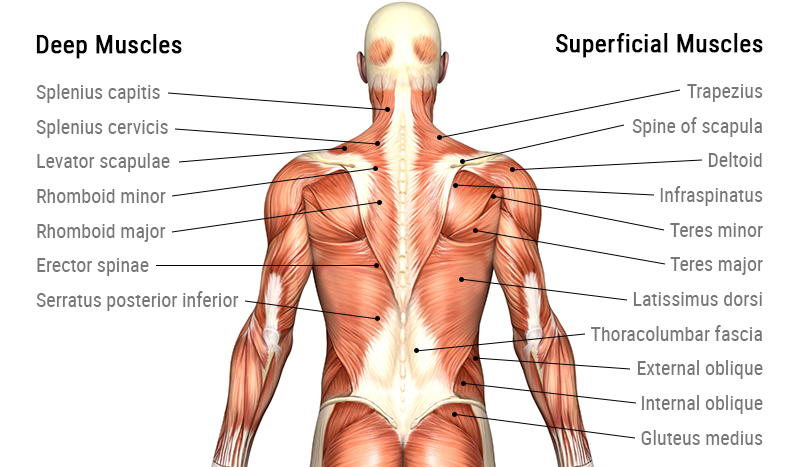Vertebrae - our very own stacking system
The back is an amazing structure. As its central support there are 33 vertebrae balancing on top of each other, held together by ligaments and cushioned by intervertebral disks. There are seven cervical vertebrae, which are the smallest and most flexible. The top two have very specific functions. The first cervical vertebra, or atlas, articulates with the base of the skull, allowing nodding movements. The second, the axis, rotates around a peg connecting into the atlas and allows turning of the head.
The 12 thoracic vertebrae provide attachments for each of the 12 pairs of ribs, and have long, bony spines projecting from the rear to prevent us from bending too far backwards. Below the thoracic vertebrae, we have the five lumbar vertebrae, which are the most solid and strong ones. However, they allow great flexibility in the lower back area. They also provide attachment for some of the big abdominal muscles.

The next five sacral vertebrae are fuse together before birth to create the sacrum. This triangular bone connects with the hip bones to form the pelvic girdle. Finally, there are four coccygeal vertebrae that fuse to form the coccyx - the remains of our tail.
Although there is only a small amount of movement between any two vertebrae, their combined small movements give the back great flexibility in most directions. The arrangement of many small bones forming a column also provides strong support and attachment points for most of the back muscles.
Name that Muscle
The main muscles each side of the back are:

Trapezius, a kite-shaped muscle covering the upper back, neck and top of the shoulder. It helps to balance the head by pulling it backwards and raises the shoulders.
Latissimus dorsi, which runs in a broad diagonal band from the lower back to under the arm. This draws the arms backwards, as in rowing.
Quadratus lumboram, a very deep muscle that connects the bottom ribs with the top of the pelvis and helps maintain the correct pelvic tilt.
Erector spinae, the muscle group that forms the rounded contours on either side of the spine, and helps to extend the spine backwards.
Gluteals, or buttock muscles, which stabilise the pelvis on the thigh.
Because muscles can only work by pulling on structure to move them, the muscles in the back can only pull backwards. In order to counteract the movements of these large muscles, it's only recently been realised the we need equally strong abdominal muscles on the front of the body to maintain good posture and a healthy back. Nowadays, however, we often don't develop the necessary strength in these muscles and the result is lower back problems that develop in our 30's and 40's.
In women, pregnancy contributes to loss of muscle tone, so they tend to suffer lower back pain at a younger age. In men, the loss of abdominal muscle tone and development of a paunch in their 40's tends to be the trigger. Back muscles can often be too tense, distorting the pelvic tilt and leading to problems with vertebral alignment. They may need to be stretched and released, rather than over-strengthened.
Stress and the Back
Some of the large muscle groups in the back are particularly vulnerable to the changes that stress causes in the body, as we need these muscles to run (lower back and buttocks) or fight (upper back and shoulders). Moreover, the modern, largely sedentary lifestyle provides too little exercise to mobilise and stretch all the back muscles properly and too much sitting, which puts a strain on the lumbar region and - if we work at a desk or keyboard - tightens the upper back and shoulders. It's little wonder that back problems are one of the main causes of working days lost in industry, not to mention the pain and suffering of the affected individual.
The mind and emotions also play a part in our body posture. A happy, confident person moves in a balanced, upright and open-bodied way. Someone who is sad, depressed, tense or anxious tends to be bowed and stooped, with an inward closed boy position.
Not only can back problems cause pain in specific area, but misalignment of the spine can lead to pressure on the nerves that leave the spinal cord between each vertebrae. These nerves lead to all our internal organs and structures, allowing the brain to control and co-ordinate our body's involuntary activities. If the nerve supply to a particular area is impaired, the circulation and lymph flow in that area will be poorer and the organ or structure may not function properly. Therapies such as osteopathy and chiropractic work to realign the spine, to relieve pain and restore full function by freeing the nerve supply from restriction.